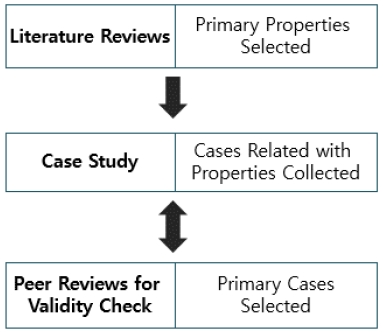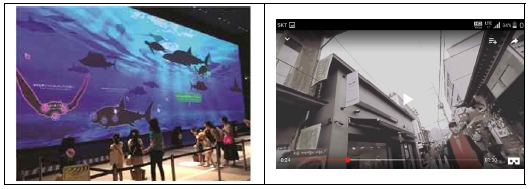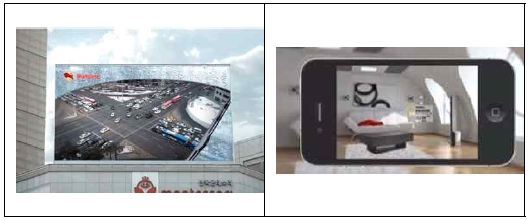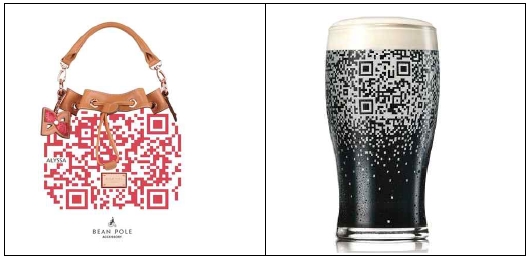
A Conceptual Study of Application of Digital Technology to OOH Advertising: Focused on Extended Reality Technology
Copyright ⓒ 2020 The Digital Contents Society
This is an Open Access article distributed under the terms of the Creative Commons Attribution Non-CommercialLicense(http://creativecommons.org/licenses/by-nc/3.0/) which permits unrestricted non-commercial use, distribution, and reproduction in any medium, provided the original work is properly cited.

Abstract
This study aims to explore the new technology properties of digital outdoor advertising and to analyze key properties of digital outdoor advertising cases focusing on realistic technologies. The results of analysis based on precedent literatures and major related cases are as follows. First, it is revealed that some well-known digital OOH advertisements tend to be combined with various extended reality(XR) technologies such as AR and VR, rather than on display itself. Second, XR campaigns with video have been increased recently rather than traditional text-based advertising. Third, public service campaign and contents including weather and environments are commonly found as well as commercial advertising ones. Fourth, digital OOH advertising that emphasizes immersion and realism is mostly found to be associated with interactive advertising campaigns.
초록
본 연구는 디지털 옥외광고의 기반이 되는 뉴 테크놀로지 속성을 탐색하고, 주요 확장현실 기술을 중심으로 디지털 옥외광고 사례를 분석하는 데 목적이 있다. 선행연구 및 주요 사례에 기반한 분석 결과는 다음과 같다. 첫째, 최근 주요 디지털 옥외광고는 디스플레이 그 자체 이상의 AR, VR을 중심으로 한 다양한 확장현실 기술과 접목되어 나타났다. 둘째, 전통적인 텍스트 중심 광고보다 확장현실 사례가 많았으며 이는 동영상이 가미되어 나타났다. 셋째, 상업성 광고 캠페인은 물론 공익성 캠페인 및 날씨, 환경 등 콘텐츠가 많이 수집되었다. 넷째, 몰입감과 현장감을 강조하는 디지털 OOH 광고 사례들은 인터랙티브 광고 캠페인과 관련하여 많이 나타났다.
Keywords:
Digital OOH(Out-Of-Home) advertising, Extended Reality(XR) Technology, VR, AR, Hologram키워드:
디지털 옥외(OOH) 광고, 확장현실 기술, 가상현실(VR), 증강현실(AR), 홀로그램I. Introduction
Since communication activities using digital media technology are increasing recently, related researches are being conducted in various applied business areas. Research in foreign countries has been conducted mainly in the fields of information communication and engineering since 2000, while, in Korea, it has been conducted mainly in design and information and engineering since late 2010[1]. Thus, rather little research has been conducted in communication studies[2].
Conceptually, digital Out-Of-Home (DOOH) advertising includes two changed concepts; digital and OOH. The digitization of outdoor advertising is a combination of both digital and traditional signage, which differs greatly from the attributes of existing signboards that display messages based mainly on text and still images.
Digital signages increase to connect cameras and sensors to hardware and process data such as consumer information and movement through real-time analysis programs. In order to provide the user with the necessary information, an optimization solution is needed. For example, the advertisement for the ‘Apotek Hjartat' hair care product, the winners of the New York Festivals and Cannes Festival's ‘Outdoor' category, was installed on the subway station platform in Stockholm, showing a woman's hairs being scattered. In order for this advertisement to be practical, a digital technology element called an ultrasonic sensing sensor that detects sound is required, and industrial understanding is required.
While touch screen kiosks installed in shopping malls and subway stations are often overlooked due to limited search and limited information, the projects that have been advanced one step have been expanded to provide information through the AI-based voice recognition interface method.
This is the case when Alexa or Google Voice, created by Amazon, works with signage to find the right data for people's voice-searched information: AV Technology and Systems Fair, Amsterdam, ISE 2017 (Integrated Systems Europe), 'Smart Platform', which combines voice recognition and IoT (Internet of Things), was also selected as the main technology (the-pr.co.kr). In addition, Alexa as well as research using Google Voice is in progress. Traditionally, there are various campaigns using NFC technology or Beacon-oriented communication technology that do not require a separate app.
Through AR Showroom, consumers can try on actual clothes (fitting service) or arrange appliances and furniture in real living spaces and check their validity in advance. KT, Hyundai Home Shopping's 'VR fitting service' and 'AR showroom' Lotte Home Shopping's 'AR view' can increase customer satisfaction and reduce complaints.
As such, the use of innovative digital advertising channels in the area of OOH advertising communication is increasing. Digital technology positively affects advertising effectiveness by providing consumers with the personalized information they need, avoiding ad clutter in outdoor situations, and engaging with brands[3]. In particular, digital technology based on consumer's sensory technology effectively turns consumers' participation into interesting space by presenting unexpected stimulus in everyday space. This is a change that is difficult to predict in the existing one-sided advertisement format using sign. It is digital technology that enables this effect.
In recent years, researches dealing with technical contents in communication, as well as in design and engineering, are being attempted from a convergence perspective. This study examines AR, VR, hologram, and communication technologies as realistic or realistic technologies, and then conceptually examines the main technical characteristics of new technology combined with digital outdoor advertising. Specifically, this study intends to classify the type of digital technology applied to outdoor advertising in terms of extended reality technology or realistic technology.
II. Research Questions and Methods
2-1 Research questions
This study aims to suggest useful implications for expanding digital outdoor advertising and increasing technology utilization for digital media communication. Two research questions are established: one is 'what are major properties of digital OOH advertising', another is 'what are the properties and factors as realistic technology in digital OOH advertising'.
2-2 Methods
Research methods were divided into three stages.
First, for literature reviews, primary attributes of digital technology including extended reality were collected. Some primary attributes were described based on the peer researcher's perspective and through discussion[20].
Second, with the description, a report was required for 42 college students in the Seoul metropolitan area. The task was assigned to investigate additional relevant attribute factors individually. A method of investigating the derivative or related key-words was recommend such as Google's extended search.
The theme of the report was “Finding attributes and technology elements of Digital OOH Advertising.” Multiple key-words were selected in order from the collected results.
Third, according to the results of the reports, some key-words were adopted, when collected plural, such as realistic technology, AR, VR, LCD, beacon, NFC, and facial recognition. The key-words were given to reaffirm the validity of the description based on previous studies and peer reviews. Based on the adopted key-words, the appropriate examples are selected and modified through Googling(Google's extended search). The structure of research methods is as in Fig. 1.
III. Literature Review
3-1 VR, AR, MR, Hologram as Extended Reality Technology
A variety of digital technologies that provide experiences are being mobilized since consumer experiences and involvement in marketing communications become important. So-called realistic technology can refer to such as VR(Virtual Reality), AR(Augmented Reality), MR(Mixed Reality), Hologram, etc. Realistic technologies reportedly provide users with an realistic experience that increases their use in marketing communications[19]. In the outdoor advertising sector, there are many cases in which digital signage such as media facades and bus shelters are combined with virtual reality technology to create a cultural art space or show brand images.
The realistic technology has suffered a slump after active investment and research in the 1990s, and has been reborn as a next-generation core technology thanks to the development of infrastructure technologies such as ICT (Information and Communications Technologies) and 5G. Google, Facebook and Microsoft. Global IT companies such as Samsung Electronics are continuing to invest in such fields[4]. Specifically, Oculus, a VR HMD production company, was acquired by Facebook for $ 2 billion, and then collaborated with Samsung Electronics to develop a Gear VR that can experience VR by inserting a Galaxy smartphone. In addition, SONY developed PSVR, a VR HMD based on PlayStation, a video game platform. Pokemon GO, an AR game that has gained popularity in Korea, is growing in interest in augmented reality technology.
It ranked first in mobile games within a day after its release in the United States. VR and AR technologies have emerged as full-fledged profit markets with the emergence of virtual reality games. Lenovo's MR experience campaign, for example, is an “Into the Wild” campaign that Lenovo in 2017 collaborated with Google and the Singapore Art Science Museum to create virtual reality using art science walls as media. . Consumers can experience the experience of planting trees by watching VR grow wild. When consumers plant trees, they support the World Wildlife Fund (WWF) to plant trees in real forests.
Recently, these VR and AR technologies have been collectively referred to as Extended Reality (XR) technologies (Software Policy Research Institute, Jan. 26, 2017; dailybizon.com).
These technologies, which have been developed around existing games, movies, and performances, are being expanded in recent years in combination with 5G commercialization. It is expected to be widely used in various industries such as e-commerce, medical service and education, and defense and game movies. In particular, the combination of broadcast communication technology and digital signage technology is likely to be used in various areas that create customer experience in outdoor advertising.
VR (Virtual Reality) is a technology that lets you experience the scenes in your computer as if they were real. VR is a mobile device-based technology that expands and shares the five senses of the user so that they can experience realistically difficult situations.
VR users can not only experience certain situations in the virtual space, such as mobile devices, but also interact with them. In short, it is a technology that creates a virtual interface between humans and computers. VR is often experienced through 360-degree video, but VR does not mean 360-degree video.
It is mainly realized in entertainment areas such as amusement parks and games, but is expected to expand to non-entertainment areas such as education.
(1) Technology properties
Technical characteristics of VR include immersion and interaction, restoration and generation[5].
First, induce immersion through visualization. realistic visualization technology. Present the virtual reality to the user so that they can see and experience it directly to the immersion. To this end, various visualization device technologies such as projection and image visualization technology SW are supported.
Second, it draws sense and interaction. Allow participants to interact with the world of virtual reality based on the five senses of the user. To this end, motion-based simulators, VR participants' location tracking, tactile, haptic, olfactory and taste related technologies are supported.
Third, create and restore the impossible world. It is possible to create a world that is impossible in reality, such as the past or the future, in virtual reality, and use it to simulate and interact with it. Virtual reality participants immerse themselves in the visible world and participate in scenarios. Based on this, you can experience contents that transcend construction such as military, medical, and education. The technology is mainly used to create virtual reality environments based on 360-degree panoramic images and reconstructions.
(2) Applied cases
VR technology is widely used in mobile advertising these days. For example, the contents look different depending on the angle of tilting or touching the smartphone to turn 360 degrees. When shooting, it is made using 360 ° technique, and the user can select the spot to see up, down, left, and right while rotating the screen. Including the Nike Hypervenom II commercial in 360-degree video format, the Santa Claus experience produced by Coca-Cola (Poland), the displaced app of the New York Times, the refrigerator of the cheese company Boursin, and the Japan Nature Experience Museum Yokohama Obi (ORBI) VR theme park.
At the 2015 Cannes ad, Google won the Mobile Grand Prix for Cardboard VR. The 360˚ VR advertisement presented by the Korean marriage information company Duo is also eye-catching. By looking around the male protagonist in the commercial, he conveys the concept that 'a good relationship may be around you.'(Fig. 2).
In addition, Topshop, a clothing brand, had store customers wear 360-degree cameras and watch the Topshop fashion show in real-time elsewhere. VR makes consumers aware of the brand and helps them make purchases on site by giving them a vivid brand experience.
As such, the proportion of content combined with 360-degree video has increased recently. 360-degree video content is realistic because you can experience the scenes in the video to be realistic. Increasingly, VR contents such as performance videos, travel, and fitness are being provided through KT's Olleh TV Mobile or LG Uplus's LTE video portal. Device technology and SW development to support this are also continuing. Global IT companies such as Samsung's Gear VR, Sony's PlayStation VR, Google's Google Glass, Facebook's Oculus Rift, Microsoft's HoloLens, and LG's VR HMD will be commercializing technology for virtual reality devices and sensors.
There is a fierce competition. The industry is paying attention to virtual reality as the next-generation killer content, and expanding the ecosystem based on 360-degree VR video content service[5].
Recently, real-time video is attracting attention as an important content. YouTube and Facebook are trying to dominate the market by providing real-time broadcast services. In the case of YouTube, for example, some stages of the Los Angeles Rock Festival were broadcast live on 360 degrees. If you use the up, down, left, and right arrow buttons on your PC or move your phone, you can view the performances, sports, etc. in the direction, and enjoy the sense of reality. The advantage is that it provides experiences to users beyond the provision of simple images.
VR was expected to generate KRW 1 trillion in new markets in 2017, and has been still in the early stages of development. VR is highly useful as branded content in that it enhances consumer immersion and experience, or engagement. In order to realize this, technology of the platform, contents, and device fields must be supported. Above all, active investment is needed for the development of various experiential contents.
Augmented Reality (AR) is a technology that combines virtual information in real time based on reality. In other words, it refers to a technology of superimposing a three-dimensional virtual image on the reality as a single image. Pokemon Go (GO), a mobile augmented reality game based on Google Maps in 2017, can be a good example.
The word 'augmented' means to show another image on the original image. AR includes augmented virtualization and is a technology in which a TUI of a real environment and a virtual environment (virtual reality) are in contact. TGI stands for Tangible User Interface, which is an interface that enables people to touch and feel digital objects(Software Policy Research. 2016).
It was reported that the distance measuring sensor(ToF) was adopted in the domestic Galaxy Note 10 Plus released in 2019 for providing AR and VR content(Korea Economy, August 15, 2019). ToF stands for 'Time of Flight' and is a technology that measures the distance of light flight time. It is often used to measure the depth of objects to implement various content functions such as AR and VR. In the future, three-dimensional subjects such as 3D can be detected through the mobile phone camera.
(1) Technology properties
AR can draw interest and participation from consumers. The main technical characteristics of AR are sensing and tracking, second, image synthesis, and third, real-time augmented reality interaction[6].
First, AR has sensing and tracking technology properties. This is a technology for precisely positioning a virtual object for augmentation in a real space, which is effective for inducing interest of a user.
Second, it refers to a technology of expressing a virtual object smoothly with an image of a real space through image synthesis technology. This is a technique for synthesizing the augmented reality that the user experiences so that there is no gap with the real space.
Third, AR requires real-time augmented reality interaction technology. This refers to a technology that allows augmented reality participants to experience virtual objects synthesized in real space in real time. This can lead to active consumer engagement and interaction.
Fourth, AR is easy to convey additional information about the object. By using interactive features, you can move as you adjust, rather than simply stunning 3D images.
(2) Applied cases
Examples of applying AR in outdoor media or situations include: The weather-linked AR advertisement of the car accessories company Bulls One shows the characteristics of the product according to real-time information. For example, on a rainy day, the display of advertisements on an outdoor billboard can be wiped off with a car wiper to show the road situation clearly, and on a snowy day, the scene is cleared of snow. In other words, the weather information is combined with the virtual scene, and the contents are provided in real time according to the weather information provided by the Meteorological Agency.
Augmented reality, on the other hand, is often used not only in product advertising, but also in outdoor advertising situations such as in combination with online shopping spaces or in ambient (eg Pirelli tires using airport cargo lanes) and digital signage (eg Pepsi Max busshelter ads). In addition, games (e.g. AR.Gun), news reports (e.g. YTN Science), education (e.g. three-dimensional coloring), tourism (e.g. tourist maps), information materials (e.g. LG Smart TV manuals) are utilized. In addition, IKEA has created augmented reality catalogs so that furniture can be placed freely in their rooms when lighted(Fig. 3). In the case of Deutsche Telekom, augmented reality events were conducted through large shopping malls and trees. You can put your own Christmas cards into Christmas tree ornaments in AR with slingshots. It is also anticipated that future game types will be popularized by combining various virtual reality experience devices and game machines.
QR (Quick Response) is a technology that is frequently used when conducting events using a brand application or mobile, and is often used for marketing in connection with online and offline advertising. If you use a QR code recognition application in such as a smartphone or tablet PC to read the QR code, you can access the product's internet site for additional information.
(1) Technology properties
QR codes have the advantage of being able to store a large amount of data compared to existing barcodes while maintaining a small size. Among the QR codes, color codes were the first solution in the United States to evolve from black and white QR codes. The design and recognition speed is much faster than the monochrome QR code.
(2) Applied cases
A typical example is 'Hyundai Motor Media Facade QR Code', which allows you to view the QR code through a large media facade. Classic examples include E-Mart (promotion using the sun and shadow at 12 to 1 o'clock with low sales), Volkswagen (A QR code is attached to the actual Volkswagen car, and the relevant data is searched on the internet as the car drives).
Other examples include Bean Pole, Guinness Beer, and Citibank's QR code. Ford Explorer magazine campaign with augmented reality(AR) and QR code is fun. After opening the app, the smartphone in the magazine ad will move when the smartphone is placed on the car above the magazine.(Fig. 4)
Recently, it is being used in various areas such as theme parks, healthcare, and cultural curation by combining with IoT (Internet of Things) technology such as Bluetooth Beacon based location information.
Since the QR code is eventually linked (connected) to any place, it is also necessary to design a well-linked place (compared to a landing page of a search advertisement) to increase marketing effectiveness.
MR(Mixed Reality) is a concept that encompasses the boundaries between VR and AR. It is a fusion of the immersion of virtual reality and the reality communication characteristics of augmented reality. MR with Hologram are called Mixed Reality.
MR is mainly presented through 3D image content based on hologram technology. Recently Microsoft announced a holographic lens, a holographic device using holographic technology, and explained that hologram technology will be used regardless of VR and AR. MR is a concept defined by Paul Milgram at the University of Toronto in 1994. It can be said that the real environment and the virtual environment are continuous sections. MR is also called the hybrid reality term, and it provides a mixture of real-world physical and virtual environments.
(1) Technology properties
MR service refers to the use of smartphone cameras and virtual characters in mobile environments to show them as if they were in the real world. Pokemon GO is known as an augmented reality game, but it has the characteristics of mixed reality in that virtual images appear as if they are naturally in the real environment through the video of the camera. For example, through the 'Selfie' camera app Snow, you can decorate or transform real-life user's face photos into funny virtual characters and share them. In detail, the five senses technology for the five senses service is based. The five senses technology is a technology that allows you to experience a variety of senses including sight, hearing, touch, smell and taste. The main development directions of the five senses technology are as follows[5]. Specifically, an optimized technology that reflects human's cognitive methods such as providing a more natural three-dimensional image and focusing problems has been developed.
In the case of hearing, technology has been developed to express relative direction and speed reflecting a listener's movement. In addition, tactile sensation was previously provided as a dedicated simulator device, but it is developing into a wearable device such as a general-purpose glove or suit. On the other hand, the sense of smell and taste differs in user preferences and sensation levels, so the utilization area is relatively limited and development speed is slow.
Hologram has a strong visual impact and are actively used in advertising videos. Currently, the technology focuses on personal experiences using 'eyeglass type' personal equipment, but it is expected to be widely used in group experience and remote experience when communication network technology will be possible in the future. Compared to 3D video, VR, etc., holograms can experience real-world three-dimensional effects.
There is not much literature on the effects of MR and holographic images in outdoor advertising. Some major attribute factors, however, mentioned in previous studies include mapping and immersion, presence, visual enjoyment, visual fatigue and human factors, stimulus salience and perceptual effects[7], [17].
(2) Applied cases
The following are five major cases related to MR and hologram technology factors centered on 3D images[7].
First, related with mapping and immersion, examples include Microsoft's Holographic Processing Unit (HPU) and Intel's RealSense technology. It enhances realism and increases the audience's immersion by providing a three-dimensional sense similar to the reality we see[8]. This is also why many documentaries and feature films are being produced in 3D.
Second, on multi-user experience technology for presence, a plurality of users have developed a technology capable of communicating and feeling the presence as if they are in the same virtual space regardless of distance. Presence means to exist or exist in a certain scene, and it means a state in which a viewer stays in the world of holographic images, leaving the space of reality.
Third, with related to the visual enjoyment, the characteristics of 3D stereoscopic images can be overall summarized as providing visual enjoyment, providing image realism, and increasing immersion of the audience. Visual enjoyment is primarily due to the illusion of 3D mapping.
3D images provide visual enjoyment that can't be felt in 2D images through pop-out and depth. Presently, 3D advertising can be presented through various technologies such as 3D hologram display LED fans.(Fig. 5)
Fourth, as to visual fatigue and human factor, as opposed to visual enjoyment, there is visual fatigue as the reality of immersion increases. Human factor refers to securing user's safety and efficiency by considering human's physical and cognitive characteristics in order to optimize user's appreciation of sensory image.
Fifth, regarding stimulus salience and perceptual effects, mentioned in research on general motion graphic and interaction design, there are differences in perceptual effects such as exposure, attention, and memory according to the severity of stimulus such as shape, motion trajectory, size, color, and brightness[9].
3-2. Digital Factors in DOOH Ad Technology
The characteristics of expression in digital OOH advertising, rather than those of extended technology can be classified into four types: informational, commercial, empirical, and behavioral attributes[10],[11]. This study classifies new digital OOH advertising technologies from the viewpoint of attributes and introduces the most applicable technology elements[11].
First, transparent LCD can be suggested for a technological factor. It refers to a thin transparent LCD installed on a builtin refrigerator door existing in a convenience store[11]. Put the liquid crystal between the two thin glass plates and insert the electrode to display the screen. Then turn on the fluorescent backlight (BLU) to make the liquid crystal visible[12].
Second, NFC belongs to the technology that is being extended to mobile technology and financial environment system.
It is defined as a contactless short-range wireless communication system[13]. The NFC system currently uses the 13.56MZ frequency band (the same to RFID) and can transfer data between terminals at a very close distance of 10cm[15]. Third, virtual presenter, an interactive information service type, is an interactive digital signage that can be used in hotels and restaurants.[11]. It has such advantages as improving brand awareness and high message delivery because it has life-like form and voice. It is expected to provide one-stop solution for contents service and hardware in the future[15].
Fourth, Rear Projection Film (RPF) is the projection of a projector behind a translucent screen to create a screen. Any type of display can be produced. Signage created in the form of figures using rear projection film is an interactive virtual presenter, or a person pop screen[14].
Fifth, as to digital signage based on motion capture, the public utility value of digital signage, which combines interactive technology such as gesture recognition, augmented reality, motion capture technology, and sensing technology with increased ease of use, is increasing[15].
Sixth, wearable digital signage platforms are receiving attention. One of the most representative cases, iWork, developed by Nomadix, is equipped with 17.5-inch LED displays and speakers. iWork is natively compatible with smartphones and iPads, and works with PlayStation and Wii.
First, as to connected consumer and RFID, digital signage, kiosks, tablets, smartphones, etc., have recently enabled consumers to have a variety of digital experiences and form more networks than ever before. Consumers who engage in social signing and dialogue through digital signage are called connected consumers[15].
Second, videowall is a shopping experience digital signage that enables interactive communication with shoppers. It provides services such as directions to each store in the shopping center and is integrated with Facebook and Twitter. When a customer searches with a QR code to go to a store, it is linked with mobile, and a loyalty card service that shows the customer's evaluation information is also shown.
Third, the virtual fitting system consists of a large screen, a tablet, and a camera. The special barcode technology allows the computer to automatically recognize the type and color of the clothes worn by the customer and to use the augmented reality technology in front of the large screen used as a mirror. Not only does LED billboard boast premium image quality, but it also has a calibration sensor that makes white balance correction[16].
Fourth, facial recognition technology applied 'Optim Eyes platform' to each digital signage to derive detailed statistical results by number of viewers. Advances in facial recognition using cameras, location-based system (LBS) technology, and user profile technology make it easier to recognize user's age, gender, and location personality.
Fitth, information on personal properties and behaviors can be displayed using IC chip information on the mobile phone, or a Panasonic touch panel can be used to search inside a large commercial facility to guide the destination information or read the store address or phone number on the mobile phone. QR codes that can be used[17],[18].
First, kiosk based on touch screen can be selected.[10]. When the user presses a desired product (for example, clothing) using the touch screen, the customer who is displayed on the screen is standing wearing the desired product.
Second, 'motionmania' is a virtual indoor playground where multiple players can interact with sound in a colorful graphic arena projected onto the floor. Motionmania is used not only in entertainment facilities, but also in hotels and resorts, children's hospitals, restaurants and museums.
Third, interactive media implements interactive features that allow consumers to participate directly or to present customized advertisements for individual consumers. The touch screen method generally uses an IP infrared method, in which a sensor is attached to a glass front to sense a touch[16].
IV. Conclusion
4-1 Summary
The results of analyzing the main properties and cases, based on precedent studies are as follows.
First, it is revealed that digital OOH advertising tends to be combined with various extended reality technologies such as AR, VR, more than on display itself. Data analysis processing technologies such as cameras and sensors have become important. Signage-based outdoor advertisements connect cameras and sensors to hardware and process data such as consumer information and movement through real-time analysis programs.
Second, interactive campaigns have become increased rather than traditional text-based advertising, according as realistic technologies with video have been increased. Interactive digital outdoor advertising has spread as interface technology has become an important technology base for outdoor advertising. Interactive technology is regarded as the information technology for which people are asking.
Third, it is found that public service campaign and contents including weather and environments are commonly found, as well as commercial advertising ones. Since the 5G era and the T-commerce market expand, related technologies will be combined and new services will be developed more actively.
Fourth, the cases of digital OOH advertising technology that emphasizes immersion and realism are expected to increase in the future, for the cases win international advertising awards for their creativity, as well as commonly seen in daily lives.
4-2 Implications and Suggestions
This study examined the new technology based on the precedent researches on digital outdoor advertising and digital communication[19]. The following points should be considered when establishing the marketer's communication direction.
First, various technologies should be fused and combined. As digital technology used only in limited space began to be used in outdoor advertisements in various living spaces, consumer information consumption patterns changed and new markets were created.
In order to increase the applicability to outdoor advertising, it should be made in an interactive form that can be interacted with, not a one-way technology that only the current audience sees. By incorporating various image technologies into digital signage interactive advertisements, consumers can actively participate and raise awareness and raise awareness.
Second, human factor should be considered while increasing immersion and presence. With the development of realistic technology in the future, it will be possible to provide users with a higher immersion and presence through outdoor advertising or advertising events.
As such, consideration for the discomfort of consumers and advertisement design reflecting this are required. In order to realize the three-dimensional technology of outdoor advertising, it is necessary to examine issues such as brightness improvement and viewing angle extension.
Third, life information content should be provided beyond commercial advertising. According to the Goldman Sachs report, the VR and AR industries are expected to grow mainly in the entertainment sectors such as games and video, but have recently been expanded to healthcare, real estate, shopping, and education.
Public cultural and public service areas such as tourism and exhibition promotion services are also highly applicable. It is desirable to plan the campaign in such a way that the agencies and marketing experts in the outdoor advertising industry can bring their voices together. For this cooperation, a communication strategy is required to build long-term brand equity beyond market performance.
References
-
Kang, H. O. (2013). Movement and Interaction Design for Digital Signage. Journal of Digital Design, 13(2), 345-354.
[https://doi.org/10.17280/jdd.2013.13.2.034]

-
Cha, W. S. (2019). A study on the Attitude and Acceptance of Users toward the High Frequency based Digital Signage-using Extended Technology Acceptance Model. Journal of Digital Contents Society, 20(8), 1593-1603.
[https://doi.org/10.9728/dcs.2019.20.8.1593]

- Yeo, M. G.. & Ko, H. J. (2017). A Study of Applicability of Programmatic Advertising to Digital Signage. Proceedings of OOH Semina, 77-85.
- FAURE, A. (2019). On the convergence between business and IT: The role of digital transformation (Doctoral dissertation), Seoul National University.
- Lee, K. H., Kim, K. H., Park, C. J., Lee, H. J., Chun, W. J., Cho, D. S., Kwon, S. J., Hong, S. J., & Kwon, E. O. (2018). The Future of VR, AR, ContentsHaDa, 2018.01.
-
Won, J. S., & Choi, S. H. (2017). The Effects of AR (Augmented Reality) Contents on User's Learning: A Case Study of Car manual Using Digital Contents. Journal of Digital Contents Society, 18(1), 17-23.
[https://doi.org/10.9728/dcs.2017.18.1.17]

-
Kim, W. H., Shim, S. W., & Sohn, B. W. (2016). An Exploratory Study on the Application of 3 Dimensional Technology into Out-Of-Home Advertising Creativities. Journal of Practical Research in Advertising and Public Relations, 9(2), 7-30.
[https://doi.org/10.21331/jprapr.2016.9.2.001]

-
McMahan, R. P., Gorton, D., Gresock, J., McConnell, W., & Bowman, D. A. (2006, November). Separating the effects of level of immersion and 3D interaction techniques. In Proceedings of the ACM symposium on Virtual reality software and technology (pp. 108-111). ACM.
[https://doi.org/10.1145/1180495.1180518]

- Yu, E. (2012). Design Attributes for Consistent User Experience of Multi Device Service. Journal of Korean Society of Design Science, 25(1), 135-144.
-
Schaeffler, J. (2012). Digital signage: software, networks, advertising, and displays: a primer for understanding the business. CRC Press.
[https://doi.org/10.4324/9780080927862]

- Kim, W. H., & Choi, Y. S. (2014). An Exploratory Study of Technological Understanding of Digital Signage and Application to Advertising Creative. Journal of Outdoor Advertising Research, 11(2), 65-100.
-
Storz, O., Friday, A., & Davies, N. (2006). Supporting content scheduling on situated public displays. Computers & Graphics, 30(5), 681-691.
[https://doi.org/10.1016/j.cag.2006.07.002]

-
Coskun, V., Ok, K., & Ozdenizci, B. (2011). Near field communication (NFC): From theory to practice. John Wiley & Sons.
[https://doi.org/10.1002/9781119965794]

-
Chen, S., Sanjana, N. E., Zheng, K., Shalem, O., Lee, K., Shi, X., ... & Lee, H. (2015). Genome-wide CRISPR screen in a mouse model of tumor growth and metastasis. Cell, 160(6), 1246-1260.
[https://doi.org/10.1016/j.cell.2015.02.038]

- KATS overseas trend p.5, 12, 35.
-
Storz, O., Friday, A., Davies, N., Finney, J., Sas, C., & Sheridan, J. (2006). Public ubiquitous computing systems: Lessons from the e-campus display deployments. IEEE Pervasive Computing, 5(3), 40-47.
[https://doi.org/10.1109/MPRV.2006.56]

-
Rekimoto, J., & Ayatsuka, Y. (2000, April). CyberCode: designing augmented reality environments with visual tags. In Proceedings of DARE 2000 on Designing augmented reality environments (pp. 1-10). ACM.
[https://doi.org/10.1145/354666.354667]

- Lee, H. M., Ryu, N. H., & Kim, E. K. (2012). A Study of Smart Augmented Reality System based on Contextual UX for the Extension of Interactivity. Journal of Korea Electronic Communication Science, 7(2), 391-399.
- Ho, Y. S., Jung, J. I., & Kang, Y. S. (2009). Technology Trends of 3D TV and Immersive Broadcasting, Kwangju Science Technology Immersive Broadcasting Institute, 446-450.
-
Flyvbjerg, B. (2006). Five misunderstandings about case-study research. Qualitative inquiry, 12(2), 219-245.
[https://doi.org/10.1177/1077800405284363]


2002: 연세대학교 언론홍보대학원 (광고홍보학 석사)
2009: 한양대학교 대학원 (광고홍보학 박사)
1988년~1994년: LGAD(HSAD) 카피라이터
2006년~현 재 : 선문대학교 미디어커뮤니케이션학과 교수
※관심분야:브랜디드 콘텐츠, 디지털 옥외광고, 인터랙티브 광고

2002: 국민대학교 대학원 (디지털미디어디자인학 석사)
2017: 한양대학교 대학원 (광고홍보학 박사)
1993년~2019년: 제일기획, 이노션, 대홍기획, 덴츠코리아
2019년~현 재 : 고신대학교 광고홍보학과 교수
※관심분야: 디지털 콘텐츠, 미디어 크리에이티브





